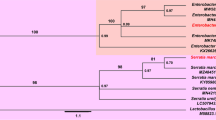Abstract
Out of 85 Bacillus thuringiensis strains isolated from Nigerian soils, 18 were larvicidal to Aedes aegypti, Culex quinquefasciatus and Anopheles gambiae. At 10−6 dilution of the final whole culture (FWC), the 11 most active strains, code-named GSC1, GSC3, GNA13, GNA14, OGL8, BUS4, BUS5, OBG1, OBG4, OBG8 and BAR3 produced mortality of 11.7–61.7% and 3.3–48.3% in Ae. aegypti and in C. quinquefasciatus fourth instars respectively. At 0.5 × 10−5 dilution of the FWC, the B.t. strains caused mortality in An. gambiae larvae ranging from 31.7 to 94.1%. All the 18 mosquitocidal isolates belonged to the subspecies israelensis, i.e. serotype 14. Microscopic examination revealed all the isolates to be typically Bacillus, with irregular or amorphous crystals of varying sizes.
Résumé
Sur 85 souches de Bacillus thuringiensis isolées des sols nigérians, 18 d’entre elles ont montré un pouvoir larvicide chez Aedes aegypti, Cidex quinquefasciatus et Anopheles gambiae. A une dilution de 10−6de la culture pure, 11 souches les plus virulentes, codées GSC1, GSC3, GNA13, GNA14, OGL8, BUS4, BUS5, OBG1, OBG4, OBG8, et BAR3 ont provoqué au niveau des 4me stades larvaires, une mortalité de 11,7% à 61,7% chez Ae. aegypti, et de 3,3% à 48,3% chez C. quinquefasciatus. A une dilution de 0,5xl0-5 de la culture pure, les souches B. thuringiensis ont induit une mortalité allant de 31,7% à 94,1% chez les larves de An. gambiae. Tous les 18 isolats appartenaient à la sous-espèce B.t. israelensis c’est-à-dire au sérotype 14. Les examens microscopiques ont révélé que tous les isolats étaient du groupe Bacillus typique, avec des cristaux irréguliers ou amorphes de tailles variées.
Similar content being viewed by others
References
Abdel-Hameed A., Carlberg G. and El-Tayeb O. M. (1990) Studies on Bacillus thuringiensis H-14 strains isolated in Egypt—I. Screening for active strains. World J. Microbiol. & Biotechnol. 6, 299–304.
Anonymous (1987) Report of an informal consultation on the detection, isolation, identification and ecology of biological agents of disease vectors. WHO Mimeograph Document, TDR/BCV/IC-CE/87.3.
Barjac H. de (1990) Characterization and prospective view of Bacillus thuringiensis israelensis, pp. 10–15. In Bacterial Control of Mosquitoes and Blackflies (Edited by H. de Barjac and D. J. Sutherland). Rutgers University Press, New Brunswick.
Balaraman K., Hoti S. L. and Manonmani L. M. (1981) An indigenous virulent strain of Bacillus thuringiensis highly pathogenic and specific to mosquitoes. Current Science 50, 199–200.
Brownbridge M. and Margalit J. (1986) New Bacillus thuringiensis strains isolated in Israel are highly toxic to mosquito larvae. J. Invertebr. Pathol. 48, 216–222.
Chilcott C. N. and Wigley P. J. (1988) Technical note: An improved method for differential staining of Bacillus thuringiensis crystals. Lett. Appl. Microbiol. 7, 67–70.
Collins C. H. and Lyne P. M. (1970) In Microbiological Mcthods 3rd edn. pp. 164–169. Butterworths, London.
Davidson E. W. and Sweeny A. W. (1983) Microbial control of vectors: A decade of progress. J. Med. Entomol. 20, 235–247.
Goldberg L. J. and Margalit J. (1977) A bacterial spore demonstrating rapid larvicidal activity against Anopheles sergentii, Uranotaenia unguiculata, Culex univitatus, Aedes aegypti and Culex pipiens. Mosq. News 37, 355–358.
Majori G. and Ali A. (1984) Laboratory and field evaluations of industrial formulations of Bacillus thuringiensis serovar. israelensis against some mosquito species of Central Italy. J. Invertebr. Pathol. 43, 316–323.
Margalit J. (1990) Discovery of Bacillus thuringiensis israelensis, pp. 3–9. In Bacterial Control of Mosquitoes and Blackflies (Edited by H. de Barjac and D. J. Sutherland). Rutgers University Press, New Brunswick.
Martin P. A. W., Haransky E. B., Travers R. S. and Reichelderfer C. H. (1985) Rapid biochemical testing of large numbers of Bacillus thuringiensis isolates using agar dots. Bio Techniques 3, 386–392.
Molloy D. and Jamnback H. (1981) Field evaluation of Bacillus thuringiensis var. israelensis as a black fly biocontrol agent and its effects on non-target stream insects. J. Econ. Entomol. 74, 314–318.
Mulligan III F. S., Schaefer C. H. and Wilder W. H. (1980) Efficacy and persistence of Bacillus sphncricus and B. thuringiensis H-14 against mosquitoes under laboratory and field conditions. J. Econ. Entomol. 73, 684–688.
Norris J. R. (1969) The ecology of serotype 4B of Bacillus thuringiensis. J. Appl. Bactcriol. 32, 261–267.
Obeta J. A. N. (1989) Field evaluation of Bacillus thuringiensis var. israelensis produced on medium made from Nigerian agricultural products. Israel J. Entomol. 23, 247–253.
Obeta J. A.N., Zaritsky A. and Barak Z. (1995) Evaluation of Bacillus thuringiensis H-14 isolates from Nigerian soils for use in mosquito control. Insect Sci. Applic. 15, 433–438.
Ohba M. and Aizawa K. (1989) Distribution of the four flagellar (H) antigenic subserotypes of Bacillus thuringiensis H serotype 3 in Japan. J. Appl. Bacterial. 67, 505–509.
Padua L. E., Ohba M. and Aizawa K. (1984) Isolation of a Bacillus thuringiensisstrain (serotype 8a: 8b) highly and selectively toxic against mosquito larvae. J. Invertebr. Pathol. 44, 12–17.
Priest F. G. (1992) Biological control of mosquitoes and other biting flies by Bacillus sphaericus and Bacillus thuringiensis. J. Appl. Bacterial. 72, 357–369.
Raun E. S., Sutter G. R. and Revelo M. A. (1966) Ecological factors affecting the pathogenicity of Bacillus thuringiensis var. thuringiensis to the European corn borer and fall armyworm. J. Invertebr. Pathol. 8, 365–375.
Sutherland D. J. (1990) The future of bacterial control of mosquito and blackfly larvae, pp. 335–342. In Bacterial Control of Mosquitoes and Blackflies (Edited by H. de Barjac and D. J. Sutherland). Rutgers University Press, New Brunswick.
Travers R. S., Martin P. A. W. and Reichelderfer C. F. (1987) Selective process for efficient isolation of soil Bacillus spp. Appl. Environ. Microbiol. 53, 1263–1266.
Zhang Y., Ku Z., Chen Z., Xu B., Yuan F., Chen G., Zhong T. and Ming G. (1984) A new isolate of Bacillus thuringiensis possessing high toxicity towards mosquitoes. Acta Microbiol. Sinica 24, 320–325.
Author information
Authors and Affiliations
Rights and permissions
About this article
Cite this article
Obeta, J.A.N. Mosquitocidal Bacillus thuringiensis from Nigerian soils. Int J Trop Insect Sci 18, 235–240 (1998). https://doi.org/10.1017/S1742758400023468
Accepted:
Published:
Issue Date:
DOI: https://doi.org/10.1017/S1742758400023468
Key Words
- mosquitocide
- Bacillus thuringiensis H-14 isolates
- Aedes aegypti
- Anopheles gambiae
- Culex quinquefasciatus
- Nigerian soils




